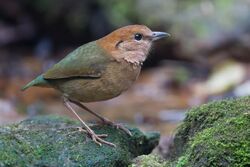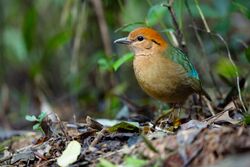Biology:Rusty-naped pitta
| Rusty-naped pitta | |
|---|---|

| |

| |
| Male and female | |
| Scientific classification | |
| Domain: | Eukaryota |
| Kingdom: | Animalia |
| Phylum: | Chordata |
| Class: | Aves |
| Order: | Passeriformes |
| Family: | Pittidae |
| Genus: | Hydrornis |
| Species: | H. oatesi
|
| Binomial name | |
| Hydrornis oatesi Hume, 1873
| |
| Synonyms | |
| |
The rusty-naped pitta (Hydrornis oatesi) is a species of bird in the family Pittidae.
Taxonomy
The rusty-naped pitta was described by Allan Octavian Hume in 1873 from specimens collected in the eastern Pegu Range, Myanmar. Hume coined the current binomial name Hydrornis oatesi.[2] The species was subsequently placed in the genus Pitta but was then moved back to the resurrected genus Hydrornis in 2006 based on the results of a molecular phylogenetic study.[3] The genus Hydrornis had been introduced by the English zoologist Edward Blyth in 1843.[4] The specific epithet was chosen to honour the amateur ornithologist Eugene William Oates who had collected the specimens.[2][5]
Four subspecies are recognised:[6]
- H. o. oatesi Hume, 1873 – from east Myanmar to northeast Laos and Thailand
- H. o. castaneiceps (Delacour & Jabouille, 1930) – southeast China to central Laos and northwest Vietnam
- H. o. bolovenensis (Delacour, 1932) – south Laos and south Vietnam
- H. o. deborah (King, BF, 1978) – central Malay Peninsula
Description
The male has a deep brown head and underparts with dull green wings. It has a well defined black stripe behind the eyes.[7] The female is duller than the male, with brownish tingeing on the wings and vague dark scaling on the lower throat.[7]
Distribution and habitat
The rusty-naped pitta is native to Indochina and adjacent parts of southern China . It inhabits subtropical or tropical moist lowland forests and subtropical, tropical moist montane forests and bamboo forests above the elevation of 800 m (2,600 ft).[7]
References
- ↑ BirdLife International (2018). "Hydrornis oatesi". IUCN Red List of Threatened Species 2018: e.T22698608A130190394. doi:10.2305/IUCN.UK.2018-2.RLTS.T22698608A130190394.en. https://www.iucnredlist.org/species/22698608/130190394. Retrieved 14 November 2021.
- ↑ 2.0 2.1 Hume, A.O. (1873). "Novelties: Hydrornis oatesi". Stray Feathers 1: 477–478. https://biodiversitylibrary.org/page/30007389.
- ↑ Irestedt, M.; Ohlson, J.I.; Zuccon, D.; Källersjö, M.; Ericson, P.G.P. (2006). "Nuclear DNA from old collections of avian study skins reveals the evolutionary history of the Old World suboscines (Aves: Passeriformes)". Zoologica Scripta 35: 567–580. doi:10.1111/j.1463-6409.2006.00249.x. http://www.nrm.se/download/18.72ab64ef10e51a5c8f4800047/Irestedt+et+al+OW+suboscines.pdf.
- ↑ Blyth, E.. "Mr Blyth's report for December meeting, 1842, with Addenda subsequently appended". Journal of the Asiatic Society of Bengal 12 (143): 925–1010, 960. https://biodiversitylibrary.org/page/40060949.
- ↑ Jobling, J.A. (2018). "Key to Scientific Names in Ornithology". in del Hoyo, J.; Elliott, A.; Sargatal, J. et al.. Handbook of the Birds of the World Alive. Lynx Edicions. https://www.hbw.com/dictionary/definition/oatesi-oatesii. Retrieved 15 January 2019.
- ↑ Gill, F.; Donsker, D., eds (2019). "NZ wrens, broadbills, pittas". World Bird List Version 8.2. International Ornithologists' Union. https://www.worldbirdnames.org/bow/nz_wrens/. Retrieved 15 January 2019.
- ↑ 7.0 7.1 7.2 Robson, C.. Birds of Thailand. pp. 150. ISBN 978-0691007014.
Wikidata ☰ Q302853 entry
 |



